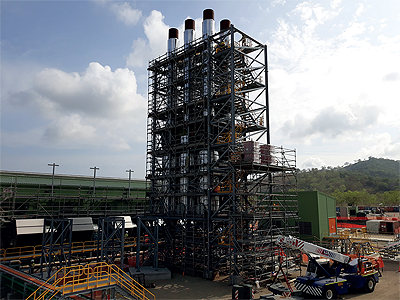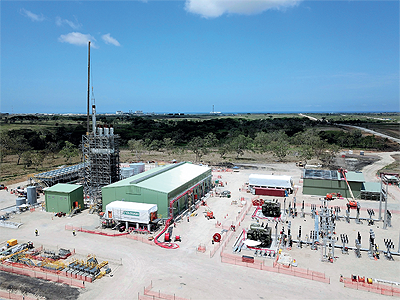Port Moresby Power Station: First Grid-Connected Gas-Fired Plant in Papua New Guinea
The power of partnership
Located in the nation’s capital city, Port Moresby Power Station is Papua New Guinea’s first dedicated, grid-connected, gas-fired power plant. The 58.7-megawatt facility was commissioned in November 2019 and is currently the biggest independent power generation asset on the Port Moresby grid. In a journey that begins over 700km away, natural gas is drawn from deep into the country’s soaring highlands before arriving via pipeline at a liquefaction plant on its way to the pioneering new site. It is a process that has been helping to supply Papua New  Guinea’s capital with electricity since the end of 2019 and NiuPower Limited hopes that will remain the case for the next 20 years.
Guinea’s capital with electricity since the end of 2019 and NiuPower Limited hopes that will remain the case for the next 20 years.
The driving force behind the construction of the Port Moresby Power Station, NiuPower is a Papua New Guinean power generation company that owns and operates the site. Established in 2017, the firm is an independent power producer (IPP) focused on providing cost-effective, natural gas-fuelled power generation for the National Capital District and Central Province of Papua New Guinea. Owned as part of a 50/50 joint venture between Kumul Petroleum Holdings and Oil Search Limited, NiuPower made the vital $100m initial investment towards the construction of the new power plant. Talking to Energy, Oil & Gas, Michael Uiari, NiuPower’s CEO, explains the early stages of the venture in more detail.
“The actual design of the facility was tendered and awarded by ExxonMobil because they had previously intended to fund and deliver the power station themselves. Plans changed however when the funding model became uncertain so NiuPower stepped into the breach and offered to fund, own and operate the power station. In 2018, two companies put up half of the capital each to allow us to do that: Kumul Petroleum – who are widely viewed as the national oil company of Papua New Guinea – and Oil Search Limited.”
A truly state-of-the-art facility, Port Moresby Power Station’s six internal combustion gas engines ensure superior thermal efficiency compared to other gas-fuelled generation options, meaning less fuel, lower costs, and lower emissions. A highly flexible dispatch allows the site to deliver any level of power, from six megawatts to 58 megawatts, to precisely match PNG Power’s demand. Developed with sustainability and corporate responsibility in mind, a Level 2 Environment Permit was fully approved and issued by Papua New Guinea’s Conservation and Environment Protection Authority for the construction and operation of the plant.
“The project cost around 100 million US dollars in total to construct and deliver,” Michael says. “It was already  confirmed that the site would be feature gas fired reciprocating engines and Finnish company Wärtsilä had already won the tender. This meant that the template was set, so when we gained control of the project, we simply took over the relationship with the engineering, procurement and construction (ECP) contractor and put in place a project management team, consisting of members from both shareholding firms, to oversee the delivery of the power station through that two-year period.”
confirmed that the site would be feature gas fired reciprocating engines and Finnish company Wärtsilä had already won the tender. This meant that the template was set, so when we gained control of the project, we simply took over the relationship with the engineering, procurement and construction (ECP) contractor and put in place a project management team, consisting of members from both shareholding firms, to oversee the delivery of the power station through that two-year period.”
Development of the power plant began in 2017, led by an EPC consortium of Wärtsilä and Clough. The construction phase of the project had a widely positive impact on the local economy, but it wasn’t without its challenges.
“Port Moresby Power Station is not a particularly large site, but I think the biggest difficulty, apart from the tight schedule, was the delay caused by regulatory hurdles and the extra work that was required to navigate our way through government involvement in the project,” Michael states. “Still, the work was completed within a reasonable timeframe and, during construction, an indigenous workforce made up around 90 per cent of our total workforce.
“Not only did the project generate jobs, but it also promoted the transfer of skills to indigenous workers, who will hopefully be able to use their new abilities in whatever employment they have been able to secure since the project’s completion. In summary, the use of local suppliers and a local workforce would have had a multiplier effect on the local economy.”
By 2030, Papua New Guinea hopes for 70 per cent of its population to have access to electricity. With Port Moresby Power Station already producing around $4 million worth of energy per month, it is expected that the facility will act as a catalyst in the country’s transition towards cheaper, more reliable power drawn from its own domestic gas resources. Capable of a staged expansion to 175 megawatts and underpinned by a long-term power purchase agreement (PPA) with state utility company PNG Power, Michael suggests that the Port Moresby Power Station project demonstrates what can be achieved elsewhere in the country.
“Both shareholders want to explore the full suite of domestic gas utilisation opportunities in Papua New Guinea,” he reveals. “Over the last three years, we have been looking very carefully at the domestic distribution of LNG around the country to displace diesel for industrial purposes and, in particular, how it can be used for power generation by PNG Power and mining customers.
“Port Moresby Power Station demonstrates that you can build a scalable, or modular, power plant, using exactly the same technology and then replicate that experience right around the country using gas that is produced domestically, lowering the unit cost of electricity to the grid and increasing reliability in the process. We are hoping that our work here will help to promote the electrification agenda and plug the gap in terms of energy generation until the country can justify investing in, and delivering, larger-scale, long term, more capital-intensive hydro power projects.
“Ultimately, large-scale hydro will be the ideal solution for Papua New Guinea because the fuel is water, so it costs nothing. The challenge is that these assets require major capital to build and can take anywhere up to five years to deliver so timing is everything. Grid demand has to be large enough to absorb generation capacity. The experience we’ve gone through in Port Moresby is one that you can replicate anywhere around the country, for industrial and residential use, until the large-scale hydro becomes a genuine possibility for this nation.”
Though the venture is a commercial undertaking and NiuPower seeks to make a profitable return for its shareholders, the company is dedicated to promoting the use of domestic gas as part of the country’s industrialisation agenda. The firm also aims to demonstrate that private sector investment in gas-fired power generation in Papua New Guinea can be practical and cost-effective.
“Diesel has been one of the primary fuels used for power generation over the years,” Michael remarks. “It’s considerably more expensive than gas is and so, in the medium-term, gas has a role to play in diesel displacement. Natural gas can provide an interim fuel solution or an intermediate fuel alternative for power generation pending the introduction of additional hydropower that will eventually provide our baseload.”
At the end of January 2020, PNG Power installed a new transmission line at the facility, enabling the power plant to fully dispatch its 58-megawatt capacity and allowing Port Moresby to realise the benefits of cheaper, more reliable, clean power, potentially eradicating long-standing issues surrounding high costs and frequent blackouts. Buoyed by the success of the country’s first power station, NiuPower hopes that the Port Moresby facility will herald a new age of gas-fired power in Papua New Guinea and spark the construction of similar sites around the nation.
“We’d like to help our customer, PNG Power, become a much more financially viable company than it has been in the past, such that it can invest in making transmission and distribution more reliable than at present – that’s where we are falling over at the moment in operating efficiently and meeting the expectations of our customers,” Michael declares. “Building on that relationship, we hope to take our partnership elsewhere in the country, where the need exists, and table a value proposition to potential industrial customers out there, such as our large mines, showing them that we can provide their power generation solutions successfully, in a way that meets their objectives.”
To realise a project of the nature of Port Moresby Power Station, in a country where any such undertaking was previously unprecedented, requires a vast amount of teamwork and co-operation. When the plant was finally commissioned, NiuPower thanked a long list of people and organisations for their help in establishing a harmonious working environment, including the local community comprising five villages, PNG Power, The Department of Lands & Physical Planning, the Department of Treasury and the Treasurer, the Bank of Papua New Guinea, the National Executive Council, the Independent Consumer and Competition Commission, the Electricity Management Committee, the Department of Petroleum and Energy, the Office of the Chief Secretary, the State Solicitor, ExxonMobil and owners of the PNG LNG Project.
In working through the development process from beginning to end, Michael believes that he has learnt some valuable lessons that could prove useful for the future of Papua New Guinea’s energy industry, especially in encouraging potential investors. “One thing I think we must not lose sight of,” he asserts, “is that the policy setting for private sector investment in the electricity sector in this country needs to become more structured and I think it’s important that the government behaves in a way that’s consistent with their policies. Secondly, I think we need an independent regulatory authority that moderates investment in the various grids across Papua New Guinea so that we can introduce investment in the electricity sector in an orderly fashion, along predictable business channels.”
Passionate about the sector and brimming with ideas for improvement, Michael is confident that Papua New Guinea is currently taking its first steps towards a brighter future and a better relationship with the way it generates energy. For now, NiuPower’s CEO is focused on ensuring that Port Moresby Power Station offers the best possible service to PNG Power customers across the region.
“In the immediate term, we’d like to bed down the business and make sure we can help get the grid in Port Moresby operating in coman optimal fashion because, at the moment, it needs quite a lot of investment to restore grid stability,” he points out. “That’s where our attention will be fixed over the next few months, but beyond that, we will look at what other opportunities exist around the country, leveraging the relationship we’ve got with our customer PNG Power.”
NiuPower
Services:: Independent power producer